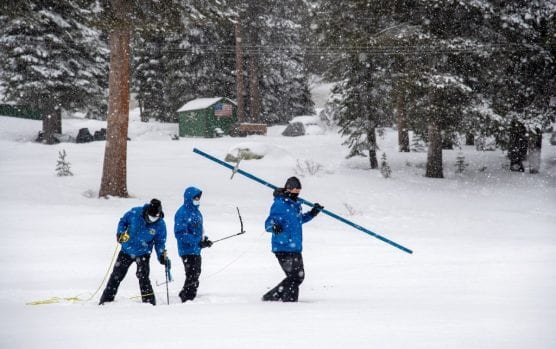The California Department of Water Resources performed a snow survey Wednesday, the results of which were decidedly mixed.
“The state experienced a series of storms over the past couple of weeks that dropped significant amounts of rain and snow,” said Sean de Guzman, the water department’s chief of snow surveys. “But it’s not nearly enough to make up the deficit we’ve experienced the last few months.”
A monster storm hammered the Sierra Nevada Mountains beginning last Wednesday, dropping enormous snow loads at the peaks, while the rain down by the coast caused flooding and an entire segment of Highway 1 through Big Sur to wash out.
But that came on the heels of an unusually dry December and January, typically two of the wettest months for California, which historically receives nearly all of its precipitation during the winter.
“We’ll need multiple days of above-average precipitation to get where we need to be and at this point, we look to be chasing average precipitation,” de Guzman said.
The snow survey conducted at Phillips Station, a stone’s throw from Lake Tahoe, revealed the snowpack is 93% of average to date and 68% of the April 1 average.
Water managers estimate the percentage of the April 1 snowpack because that is historically when the snowpack in the Sierra Nevada is at its peak. For California to have an average water year, it will need to be at 100% of the average by April 1.
It is two-thirds of the way there but will need to catch up with a wet February and perhaps some storms into March and April, the snow survey showed. The short-term forecast for rain and snow is not promising.
“While there is still a chance we will see additional storms in the coming weeks, the department and other state agencies are preparing for the potential for a second consecutive year of dry conditions,” said Karla Nemeth, director of the water department.
Water managers did note on Wednesday that that snowpack, measuring at 63 inches, is larger than last year at the same time, but the measurement also belied problems in the southern reaches of the Sierra Nevada.
For instance, a measurement of the snowpack at Donner Summit revealed it is right where it should be for this time of year, or relatively so, coming in at 89% of average. However, a similar measurement at Panther Meadows in Sequoia National Park registered the snowpack at 46% of average.
Part of the problem is the fall in the Sierra was abnormally dry, following a dry winter that began the previous autumn.
The Sierra Nevada mountain range plays an integral role in water supply in a state that enjoys a Mediterranean climate marked by dry sunny summers with periods of inclement weather restricted to the late fall, winter, and early spring.
Houses, farms, and businesses receive 60% of their water supply from the Sierra Nevada. Building up a large snowpack is crucial so that its melting can incrementally replenish California’s complex system of reservoirs and water channels that help deliver water to all corners of the arid state.
The Golden State is only a few years removed from a devastating five-year drought that still manifests itself in the sheer volume of tree mortality throughout the state’s forests and the large-scale forest fires that have scorched millions of acres in recent years.
If Mother Nature’s faucet doesn’t turn on in February, March, and April, Californians could be in for more restrictions on water usage.
“The water supply is looking better compared to where we were last week, but by no means are we out of the woods,” de Guzman said.
— By Matthew Renda, CNS
Like this:
Like Loading...
Related





 Tweet This
Tweet This Facebook
Facebook Digg This
Digg This Bookmark
Bookmark Stumble
Stumble RSS
RSS


























REAL NAMES ONLY: All posters must use their real individual or business name. This applies equally to Twitter account holders who use a nickname.
0 Comments
You can be the first one to leave a comment.